Technical–Economic Analysis for Ammonia Ocean Transportation Using an Ammonia-Fueled Carrier
Abstract
:1. Introduction
2. Ammonia Energy Supply Chain and Evaluation Boundary
- Ship size;
- Fuel;
- Main and auxiliary engine load;
- Ship speeds;
- Port in and out times;
- Loading/unloading times.
3. Ammonia-Fueled Ammonia Carrier
4. Cost Estimation
4.1. Scenario
4.2. Methodology for Cost Estimation
5. Results and Discussion
5.1. LCC for Ammonia Transportation
5.2. Sensitivity Analysis
5.2.1. Method of Ship Acquisition
5.2.2. Lifespan
5.2.3. Average Speed
5.2.4. Harbor In/Out Time
5.2.5. Loading/Unloading Time
5.2.6. Annual Inspection Time
5.2.7. Fuel Price
6. Conclusions
Author Contributions
Funding
Institutional Review Board Statement
Informed Consent Statement
Data Availability Statement
Conflicts of Interest
References
- Enerdata_World Energy Climate Statistics Yearbook 2023. Available online: https://yearbook.enerdata.net/electricity/world-electricity-production-statistics.html (accessed on 21 November 2023).
- BP. Statistical Review of World Energy 2021. BP Energy Outlook 2021 2021, 70, 8–20. [Google Scholar]
- Lee, S.; Lee, H.J. Potential applicabilities of ammonia in future hydrogen energy supply industries. Appl. Chem. Eng. 2019, 30, 667–672. [Google Scholar] [CrossRef]
- Joung, T.H.; Kang, S.G.; Lee, J.K.; Ahn, J. The IMO initial strategy for reducing Greenhouse Gas(GHG) emissions, and its follow-up actions towards 2050. J. Int. Marit. Saf. Environ. Aff. Shipp. 2020, 4, 1–7. [Google Scholar] [CrossRef]
- Pali, B.S.; Vadhera, S. Renewable energy systems for generating electric power: A review. In Proceedings of the 2016 IEEE 1st International Conference on Power Electronics, Intelligent Control and Energy Systems (ICPEICES), Delhi, India, 4–6 July 2016; pp. 1–6. [Google Scholar] [CrossRef]
- Al-Ghussain, L.; Abubaker, A.M.; Darwish Ahmad, A. Superposition of Renewable-Energy Supply from Multiple Sites Maximizes Demand-Matching: Towards 100% Renewable Grids in 2050. Appl. Energy 2021, 284, 116402. [Google Scholar] [CrossRef]
- Rahman, M.M.; Oni, A.O.; Gemechu, E.; Kumar, A. Assessment of energy storage technologies: A review. Energy Convers. Manag. 2020, 223, 113295. [Google Scholar] [CrossRef]
- Evans, A.; Strezov, V.; Evans, T.J. Assessment of utility energy storage options for increased renewable energy penetration. Renew. Sustain. Energy Rev. 2012, 16, 4141–4147. [Google Scholar] [CrossRef]
- Wulf, C.; Linßen, J.; Zapp, P. Review of power-to-gas projects in Europe. Energy Procedia 2018, 155, 367–378. [Google Scholar] [CrossRef]
- Vandewalle, J.; Bruninx, K.; D’Haeseleer, W. Effects of large-scale power to gas conversion on the power, gas and carbon sectors and their interactions. Energy Convers. Manag. 2015, 94, 28–39. [Google Scholar] [CrossRef]
- Lewandowska-Bernat, A.; Desideri, U. Opportunities of power-to-gas technology in different energy systems architectures. Appl. Energy 2018, 228, 57–67. [Google Scholar] [CrossRef]
- Sterner, M.; Specht, M. Power-to-Gas and Power-to-X—The History and Results of Developing a New Storage Concept. Energies 2021, 14, 6594. [Google Scholar]
- Ozturk, M.; Dincer, I. A comprehensive review on power-to-gas with hydrogen options for cleaner applications. Int. J. Hydrogen Energy 2021, 46, 31511–31522. [Google Scholar] [CrossRef]
- Wijayanta, A.T.; Oda, T.; Purnomo, C.W.; Kashiwagi, T.; Aziz, M. Liquid hydrogen, methylcyclohexane, and ammonia as potential hydrogen storage: Comparison review. Int. J. Hydrogen Energy 2019, 44, 15026–15044. [Google Scholar] [CrossRef]
- Lee, J.; Choi, Y.; Choi, J. Techno-Economic Analysis of NH3 Fuel Supply and Onboard Re-Liquefaction System for an NH3-Fueled Ocean-Going Large Container Ship. J. Mar. Sci. Eng. 2022, 10, 1500. [Google Scholar] [CrossRef]
- Raab, M.; Maier, S.; Dietrich, R.U. Comparative techno-economic assessment of a large-scale hydrogen transport via liquid transport media. Int. J. Hydrogen Energy 2021, 46, 11956–11968. [Google Scholar] [CrossRef]
- Ishimoto, Y.; Voldsund, M.; Nekså, P.; Roussanaly, S.; Berstad, D.; Gardarsdottir, S.O. Large-scale production and transport of hydrogen from Norway to Europe and Japan: Value chain analysis and comparison of liquid hydrogen and ammonia as energy carriers. Int. J. Hydrogen Energy 2020, 45, 32865–32883. [Google Scholar] [CrossRef]
- Sekkesaeter, Ø. Evaluation of Concepts and Systems for Marine Transportation of Hydrogen. Master’s Thesis, Norwegian University of Science and Technology, Trondheim, Norway, 2019. [Google Scholar]
- Fúnez Guerra, C.; Reyes-Bozo, L.; Vyhmeister, E.; Jaén Caparrós, M.; Salazar, J.L.; Clemente-Jul, C. Technical-economic analysis for a green ammonia production plant in Chile and its subsequent transport to Japan. Renew. Energy 2020, 157, 404–414. [Google Scholar] [CrossRef]
- Franco, B.A.; Baptista, P.; Neto, R.C.; Ganilha, S. Assessment of offloading pathways for wind-powered offshore hydrogen production: Energy and economic analysis. Appl. Energy 2021, 286, 116553. [Google Scholar] [CrossRef]
- Voniati, G.; Dimaratos, A.; Koltsakis, G.; Ntziachristos, L. Ammonia as a Marine Fuel towards Decarbonization: Emission Control Challenges. Sustainability 2023, 15, 15565. [Google Scholar] [CrossRef]
- Machaj, K.; Kupecki, J.; Malecha, Z.; Morawski, A.W.; Skrzypkiewicz, M.; Stanclik, M.; Chorowski, M. Ammonia as a potential marine fuel: A review. Energy Strateg. Rev. 2022, 44, 100926. [Google Scholar] [CrossRef]
- Hansson, J.; Brynolf, S.; Fridell, E.; Lehtveer, M. The potential role of ammonia as marine fuel-based on energy systems modeling and multi-criteria decision analysis. Sustainability 2020, 12, 3265. [Google Scholar] [CrossRef]
- Ammonia Energy Value Chain for Carbon Neutrality from Production to Utilization. Available online: https://www.ihi.co.jp/en/technology/techinfo/contents_no/1199389_13586.html (accessed on 21 November 2023).
- Egerer, J.; Grimm, V.; Niazmand, K.; Runge, P. The economics of global green ammonia trade—“Shipping Australian wind and sunshine to Germany”. Appl. Energy 2023, 334, 120662. [Google Scholar] [CrossRef]
- Seo, Y.; Han, S. Economic evaluation of an ammonia-fueled ammonia carrier depending on methods of ammonia fuel storage. Energies 2021, 14, 8326. [Google Scholar] [CrossRef]
- Wartsila Provides LFSS Solution to BW LPG’s VLGC Vessels. Available online: https://www.ship-technology.com/news/wartsila-lfss-bw-lpg-vessels/?cf-view (accessed on 21 November 2023).
- Growing Orders for Alfa Laval FCM LPG Fuel Supply Systems Reflect Strength in Alfa Laval’s Broad LPG Offering. Available online: https://www.alfalaval.kr/media/news/2022/growing-orders-for-alfa-laval-fcm-lpg-fuel-supply-systems-reflect-strength-in-alfa-laval-s-broad-lpg-offering/ (accessed on 21 November 2023).
- Seo, Y.; Kim, J.; Park, E.; Lee, J.; Cho, M.; Han, S. Analysis of Energy Consumption of Novel Re-Liquefaction System Integrated with Fuel Supply System (FSS) for LPG-Fuelled LPG Carrier to Conventional Systems. Energies 2022, 15, 9384. [Google Scholar] [CrossRef]
- Berthelsen, F.H.; Nielsen, U.D. Prediction of ships’ speed-power relationship at speed intervals below the design speed. Transp. Res. Part D Transp. Environ. 2021, 99, 102996. [Google Scholar] [CrossRef]
- Statista. Average Speed of Vessels in the World Merchant Fleet in 2018, by Ship Type. Available online: https://www.statista.com/statistics/1268217/average-speed-of-ships-by-ship-type/ (accessed on 21 November 2023).
- Aabo, K. Ammonia-fuelled MAN B&W 2-Stroke Dual-fuel Engines. J. JIME 2020, 55, 62–69. [Google Scholar]
- MAN Energy Solutions. MAN B&W Two-Storke Engine Operting on Ammonia; Man Energy Solutions: Augsburg, Denmark, 2021. [Google Scholar]
- Wartsil Test-Runs 90 Percent Ammonia-Fueled Engine. Available online: https://shippingwatch.com/regulation/article15928061.ece (accessed on 21 November 2023).
- WinGD on Track to Deliver Ammonia Engines in 2025. Available online: https://www.wingd.com/en/news-media/press-releases/wingd-on-track-to-deliver-ammonia-engines-in-2025/ (accessed on 21 November 2023).
- WinGD and HHI to Partner on Development of NH3 Engine. Available online: https://www.ship-technology.com/news/wingd-hyundai-ammonia-engine/ (accessed on 21 November 2023).
- KR. Guidelines for Ships Using Ammonia as Fuels; Korean Regist: Busan, Republic of Korea, 2021. [Google Scholar]
- Clarksons Research. World Shipyard Monitor; Clarkson Research Services Limited: London, UK, 2021; Volume 28. [Google Scholar]
- SEA/LNG. LNG as a Marine Fuel—The Investment Opportunity; SEA/LNG Ltd.: Oxford, UK, 2019. [Google Scholar]
- World Bunker Prices. Available online: https://shipandbunker.com/prices (accessed on 14 August 2023).
- Green Ammonia Fuel Faces Three Big Challenges. (Posted 17 February 2022). Available online: https://sustainability.crugroup.com/article/green-ammonia-fuel-faces-three-big-challenges (accessed on 21 November 2023).
- Clarksons Research. Clarksons Research, Shipping Review and Outlook March 2022; Clarksons Research: London, UK, 2022. [Google Scholar]
- Fuel ammonia supply chain public-private task force. Fuel ammonia supply cost analysis (Interim report). In Proceedings of the Second International Conference on Fuel Ammonia, Online, 28 September 2022. [Google Scholar]





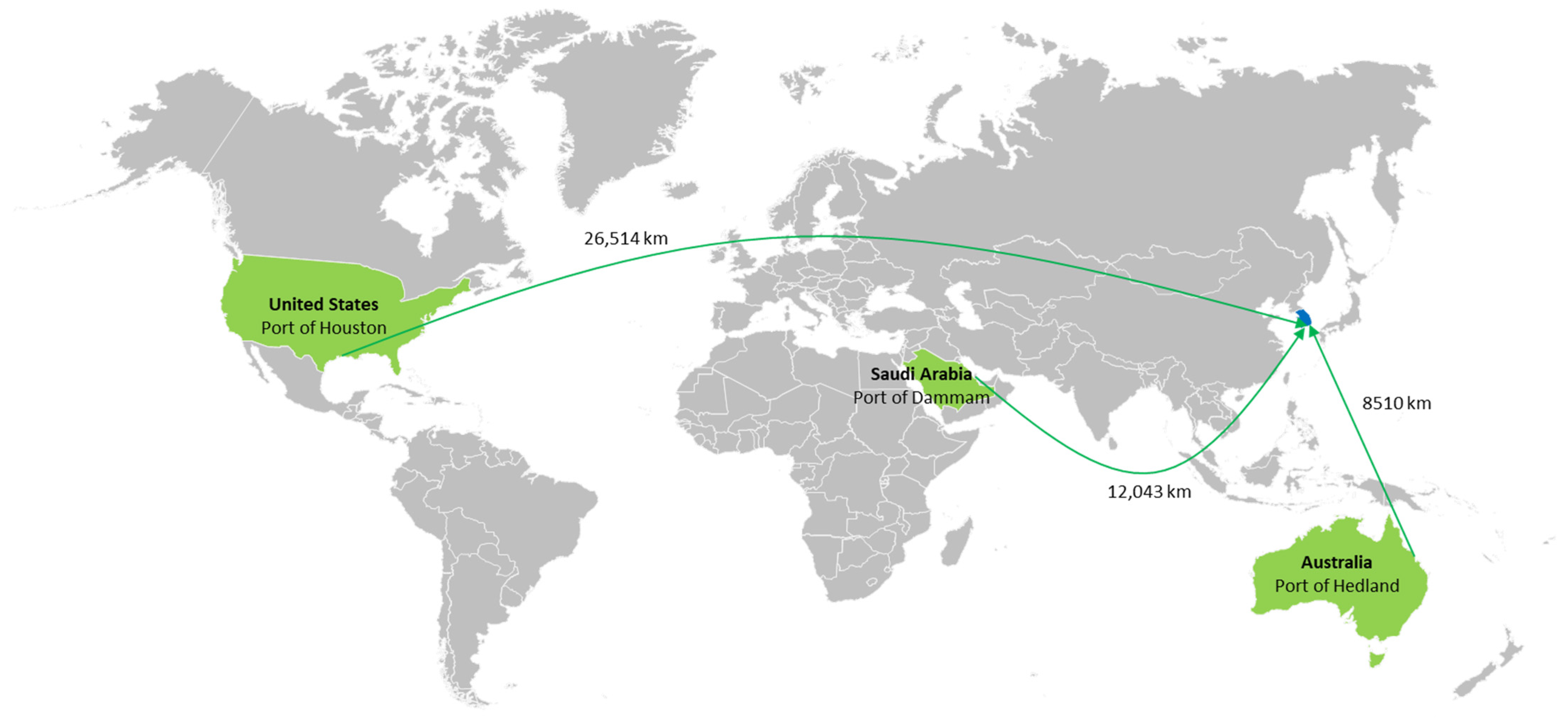

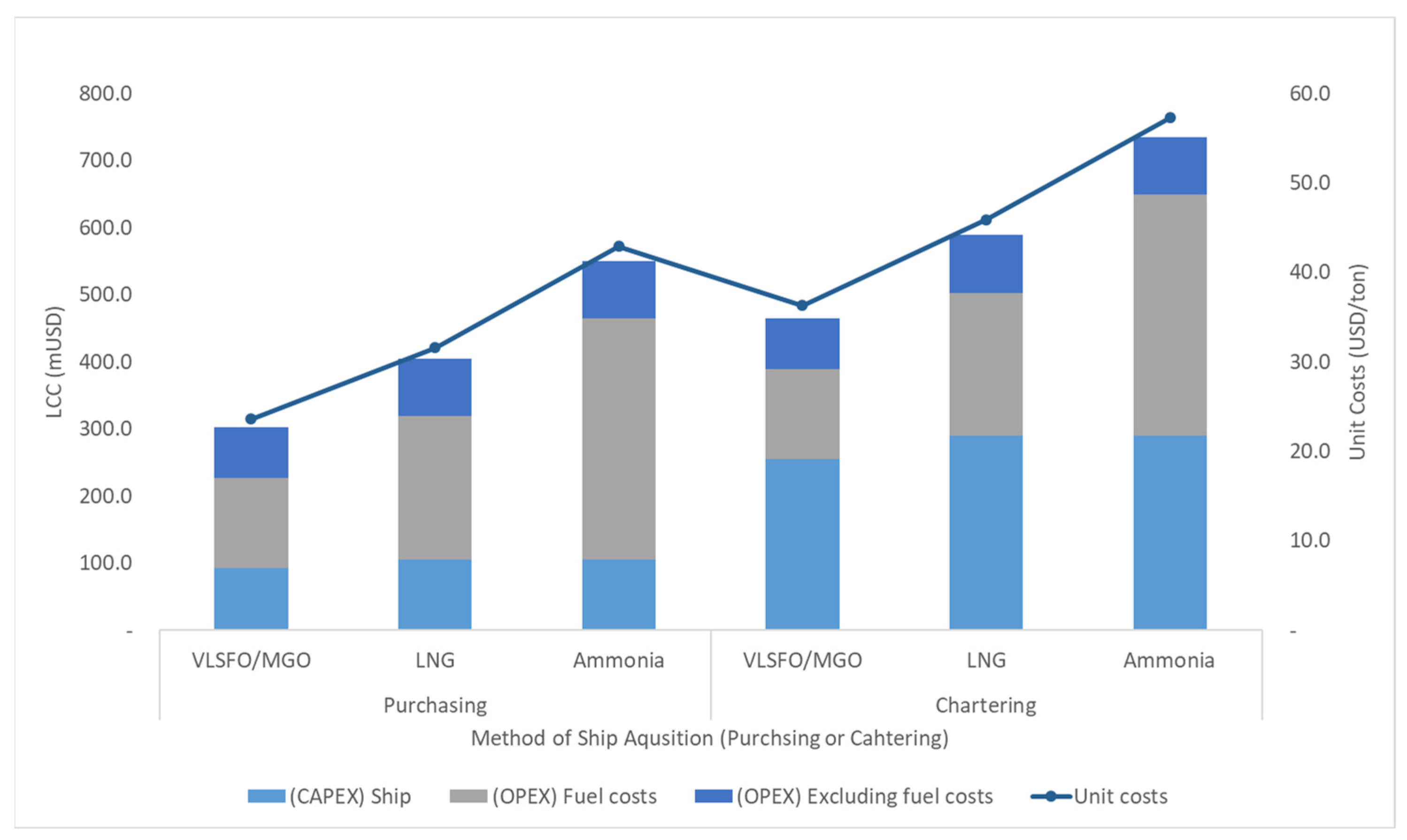



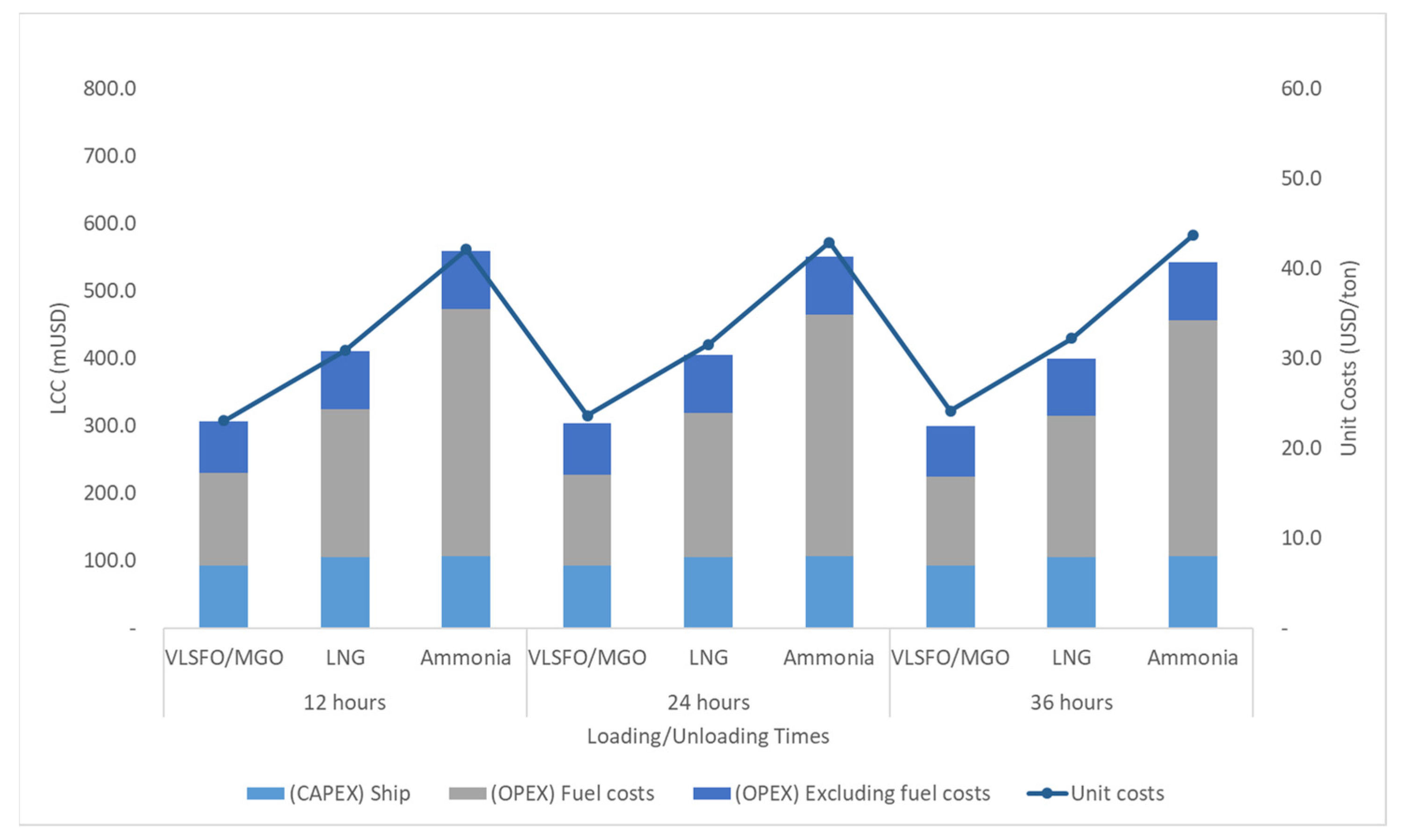
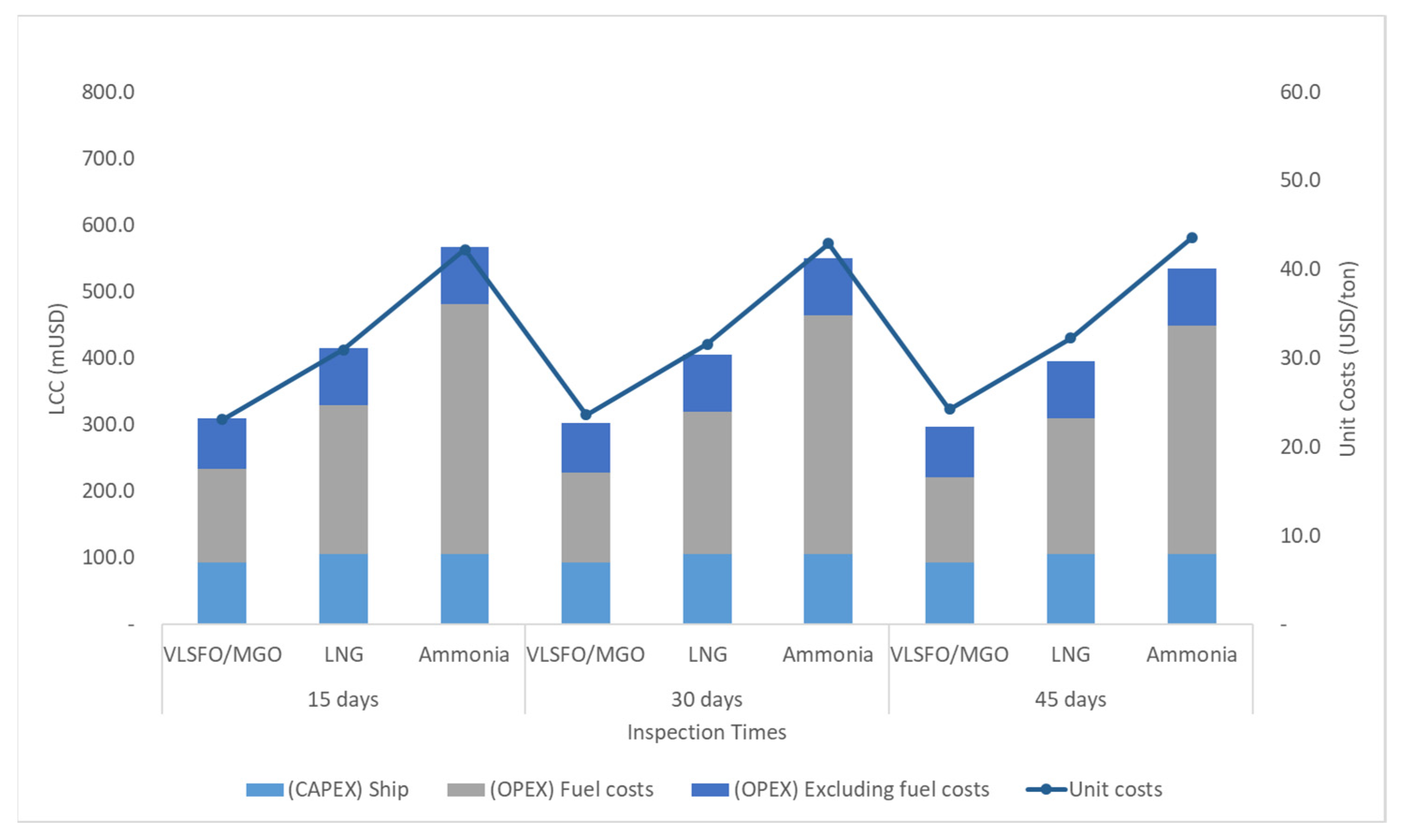
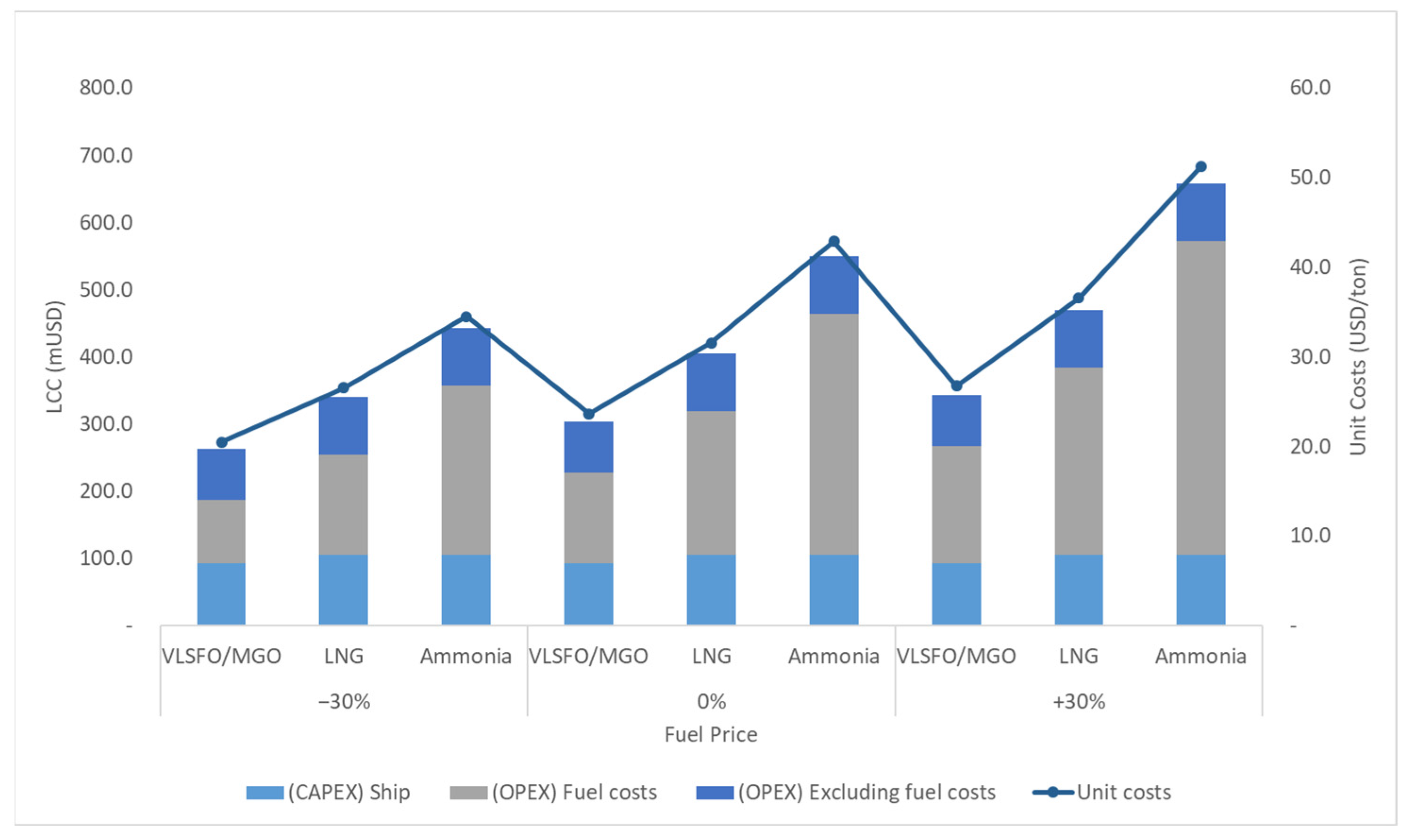
| Property | Unit | LH2 | LOHC (TOL-MCH) | Liquid NH3 | Reference |
|---|---|---|---|---|---|
| Molecular weight | - | 2.016 | 92.14/98.19 | 17.03 | [14] |
| Density | kg/m3 | 70.8 | 867/769 | 682 | [14,15] |
| Boiling temperature at 1 bar | °C | −252.9 | 110/101 | −33.34 | [14,15] |
| Gravimetric H2 density | wt% | 100 | 6.16 | 17.8 | [14,15] |
| Volumetric H2 density | kg-H2/m3 | 70.8 | 47.1 | 120.3 | [14] |
| Advantages | - | High pure H2 | Easy handling | Easy handling | [14] |
| Disadvantages | - | Liquefaction, BOG | Dehydrogenation | Cracking, toxic | [14] |
| Item | Value | ||
|---|---|---|---|
| Capacity | 84,000 m3 (57,000 tons) | ||
| Fuel (main/auxiliary) | VLSFO/MGO | LNG/LNG | Ammonia/Ammonia |
| Capacity of main engine | SMCR 13,300 kW (7770 kW at average speed 14.8 knots) | ||
| Capacity of main engine | 1400 kW × 3 + 800 kW × 1 | ||
| Average speed | 14.8 knots | ||
| Port in/out time each | 12 h | ||
| Loading/unloading time each | 24 h | ||
| Inspection time per year | 30 days | ||
| Lifespan | 20 years | ||
| Item | Price | Remark and References |
|---|---|---|
| New building price for a propulsor using conventional fuels | USD 71.0 m | [38] |
| New building price for a propulsor using ammonia | USD 80.7 m | [38,39] |
| New building price for a propulsor using LNG | USD 80.4 m | [26,38] |
| New building price for a propulsor using conventional fuels (70% loan) | USD 93.1 m | [26,38,39] annual interest rate of 5% and equal repayment of the principal and interest over 15 years |
| New building price for a propulsor using ammonia (70% loan) | USD 105.8 m | |
| New building price for a propulsor using LNG (70% loan) | USD 105.5 m | |
| VLSFO bunkering price | 631 USD/t | [40] |
| MGO bunkering price | 816 USD/t | [40] |
| Ammonia fuel price | 777 USD/t | [41] |
| LNG bunkering price | 1366 USD/t | [40] |
| Cost for ports (loading or discharging) | 55,000 USD/per | [42] |
| Cost for Panama Canal (laden and ballast) | 700,000 USD/per | [42] |
Disclaimer/Publisher’s Note: The statements, opinions and data contained in all publications are solely those of the individual author(s) and contributor(s) and not of MDPI and/or the editor(s). MDPI and/or the editor(s) disclaim responsibility for any injury to people or property resulting from any ideas, methods, instructions or products referred to in the content. |
© 2024 by the authors. Licensee MDPI, Basel, Switzerland. This article is an open access article distributed under the terms and conditions of the Creative Commons Attribution (CC BY) license (https://creativecommons.org/licenses/by/4.0/).
Share and Cite
Seo, Y.; An, J.; Park, E.; Kim, J.; Cho, M.; Han, S.; Lee, J. Technical–Economic Analysis for Ammonia Ocean Transportation Using an Ammonia-Fueled Carrier. Sustainability 2024, 16, 827. https://doi.org/10.3390/su16020827
Seo Y, An J, Park E, Kim J, Cho M, Han S, Lee J. Technical–Economic Analysis for Ammonia Ocean Transportation Using an Ammonia-Fueled Carrier. Sustainability. 2024; 16(2):827. https://doi.org/10.3390/su16020827
Chicago/Turabian StyleSeo, Youngkyun, Jiyoung An, Eunyoung Park, Jintae Kim, Meangik Cho, Seongjong Han, and Jinkwang Lee. 2024. "Technical–Economic Analysis for Ammonia Ocean Transportation Using an Ammonia-Fueled Carrier" Sustainability 16, no. 2: 827. https://doi.org/10.3390/su16020827





